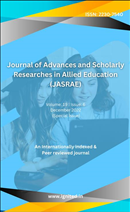A Review of a Groundwater Quality Study based on the theoretical and literature evidence
Keywords:
Groundwater, Contamination, Ion Chemistry, Jharkhand, Water Quality Parameters are some of the topics that will be discussedAbstract
The most important and significant source of potable water in the world is groundwater. In the state of Jharkhand, groundwater is utilised for a variety of reasons, including irrigation, mining, residential usage, and even drinking water. Because the groundwater in many areas of Jharkhand is contaminated with dangerous chemicals such as fluoride, arsenic, heavy metals, and iron, amongst others, certain populations in Jharkhand are forced to endure water shortages due to a lack of access to clean drinking water, while other populations only have limited access to this resource. This study looks at the present situation of groundwater in Jharkhand, as well as the pollution of several water quality metrics based on the chemistry of key ions. Water temperature, pH, electrical conductivity, total dissolved solid, total hardness, calcium, magnesium, iron, sodium, potassium, chloride, fluoride, arsenic, carbonate, bicarbonate, phosphate, nitrate, and sulphate are the water quality characteristics that are covered in this research.
References
Ambiga, K.; Anna, D.R. The International Journal of Engineering and Science.2013, 2(01), 263-268.
Banerjee, M.; Mukherjee, A. J. Sci. Res.2013, 4(2), 87-92.
Central Ground Water Board, (CGWB), Government of India, Jharkhand, http://cgwb.gov.in/District_Profile/ Jharkhand_district profile.html.
Department of Mines & Geology, Government of Jharkhand, Minerals Resources of Jharkhand, http://www.jharkhandminerals .gov.in/ portletContent/30/40.
Ground water year book Jharkhand, (2015 – 2016), Government of India, Ministry of water resources, RD & GR central ground water board.
Gupta, K.S.; Kumar, N.; Dubey, U. International Journal of Advance Research in Science and Engineering.2016, 5(03), 534-539.
https://www.britannica.com/place/Jharkhand/Government-and-society (27.12.2019).
Indian Standard, Drinking Water –Specification, (Second Revision), (2012), IS 10500, ICS 13.060.20.
JHARKHAND AT A GLANCE, https://www.jharkhand.gov.in/.
Kannel, P.R.; Lee, S.; Lee, Y.; Kannel, S.R.; Khan, S.P.Environmental Monitoring Assessesment. 2007,132, 93–110.
Khwaja, M.; Aggarwal, A.V.Current World Environment.2014, 9(3), 851-857.
Kirti, A.; Pathak, G.; Nathawat, M.S.; Jha, U.; Kumari, N.Environmental Monitoring Assessessment. 2010, 167, 617–623.
Kumar, A.; Sharma, M.P. Proceedings of 2nd The IRES International Conference, Berlin, Germany, 13th June 2015, ISBN: 978-93-85465-28-4.
Kumari, N.; Pathak, G.Journal of Engineering Research and Applications. 2014, 4(3), 65-77.
Mutiu, A.; Alabi, G.I.; Olalekan, H.O.; Rita, M.S.; Temitope, O.; Folake, G.O.; Stella, O.IOSR Journal Of Environmental Science, Toxicology And Food Technology. 2013, 6(3), 57-63.
Nayek, B.; Das, B.; Mukherjee, C.S.; Pal, A.; Ahamed, S.; Hossain, M.A.; Maity, P.; Dutta, N.R.; Dutta, S.; Chakarborti, D. Toxicological & Environmental Chemistry. 2008, 90(4), 673–694.
Pandey, A.C.; Shekhar, S.; Nathwat, M.S. Indian Journal of Applied Science. 2012, 12(9), 882- 887.
Patolia, P.; Sinha, A. Arab J Geosci, 2017, 10, 381.
Pramanik, K.A.; Majumdar, D.; Chatterjee, A. Analytical Chemistry Letters, 2020, 10:5, 684-702.
Pramanik, K.A.; Majumdar, D.; Chatterjee, A. Water Science. 2020, 34:1, 85-97.
Ranjan, R.;Sinha, K.S. International Journal of Scientific & Engineering Research. 2017, 8(6), 565-567.
Sagar, S.S.; Chavan, R.P.; Patil, C.L.; Shinde, D.N.; Kekane, S.S. International Journal of Chemical Studies.2015, 3(4), 24-28.
Singh, K.A.; Mondal, G.C.; Singh, T.B.; Singh, S, Tewary, B.K.; Sinha, A.Environ Earth Sci.2012, 67, 2175-2191.
Singh, K.P.; Tiwari. K.A.; Singh, K.P. Current World Environment. 2014, 9(3), 804-813.
Singh, P.; Tiwari, K.A.; Singh, K.P. International Journal of ChemTech Research. 2015, 07(01), 73-79.
Sinha, K.S.International Journal of Scientific & Engineering Research. 2017, 8(6), 565-567.
Thapa, R.; Gupta, S.; Kaur, H.; Baski, R. Hydro Research. 2019, 2, 60-68.
Tirkey, P.; Bhattacharya, T.; Chakarborty, S.; Baraik, S. Groundwater for Sustainable Development. 2017, 5, 85-100.
Tirkey, P.; Bhattacharya, T.; Chakraborty, S. Current Science. 2016,110(1), 10.
Tyagi, S.; Singh, P.; Sharma, B.; Singh, R. Applied Ecology and Environmental Sciences. 2014, 2(4), 94-99.
WHO (2017). Guidelines for Drinking Water Quality.4th edition. World Health Organization.









